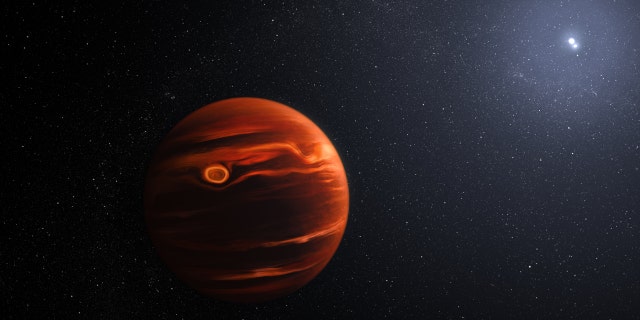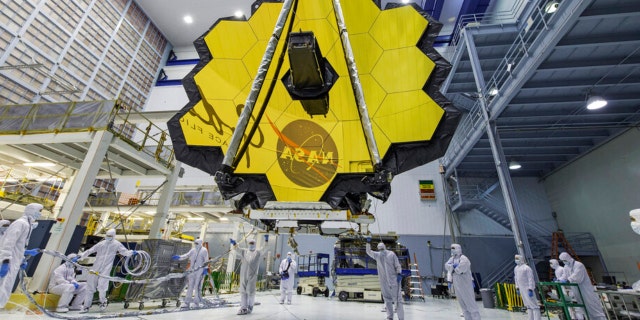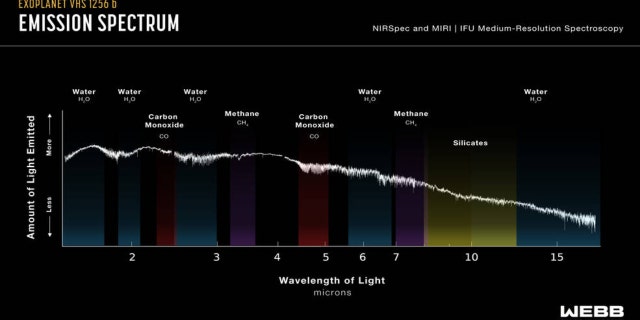Researchers working with data from the James Webb Space Telescope have spotted silicate cloud features in a distant planet's atmosphere.
NASA said that the atmosphere of the "Tatooine-like world," known as VHS 1256 b, is constantly rising, mixing and moving during its 22-hour day.
As the atmosphere constantly brings hotter material up – with high temperatures reaching 1,500 degrees Fahrenheit – and pushes colder material down, the result is dramatic brightness changes.
"The resulting brightness changes are so dramatic that it is the most variable planetary-mass object known to date," NASA said in a release.
NASA SEES ACTIVE VENUS VOLCANO FOR FIRST TIME EVER

This illustration conceptualizes the swirling clouds identified by the James Webb Space Telescope in the atmosphere of exoplanet VHS 1256 b. The planet is about 40 light-years away and orbits two stars that are locked in their own tight rotation. Its clouds, which are filled with silicate dust, are constantly rising, mixing, and moving during its 22-hour day. (Credits: Illustration: NASA, ESA, CSA, Joseph Olmsted (STScI))
The larger silicate dust grains in the atmosphere may be like very hot, small sand particles.
Furthermore, the scientists also identified the largest number of molecules all at once on a planet outside our solar system, making detections of water, methane and carbon monoxide.
VHS 1256 b is about 40 light-years away from Earth and orbits two stars over a 10,000-year period.
The exoplanet's turbulent skies are due to a couple of factors.

FILE - In this April 13, 2017, photo provided by NASA, technicians lift the mirror of the James Webb Space Telescope using a crane at the Goddard Space Flight Center in Greenbelt, Md. ((Laura Betz/NASA via AP, File) )
It has low gravity compared to more massive brown dwarfs, meaning that silicate clouds can appear and remain higher in the atmosphere. Plus, in astronomical terms, it's a young planet; only 150 million years have passed since it formed.
NEIL DEGRASSE TYSON SAYS JAMES WEBB SPACE TELESCOPE IS WINDOW TO UNIVERSE 'NEVER BEFORE ACHIEVED'
Although all the features the team observed have been spotted on other planets elsewhere in the Milky Way by other telescopes, other research teams typically identified only one at a time.

A research team led by Brittany Miles of the University of Arizona used two instruments known as spectrographs aboard the James Webb Space Telescope, one on its Near Infrared Spectrograph (NIRSpec) and another on its Mid-Infrared Instrument (MIRI) to observe a vast section of near- to mid-infrared light emitted by planet VHS 1256 b. They plotted the light on the spectrum, identifying signatures of silicate clouds, water, methane and carbon monoxide. They also found evidence of carbon dioxide. (Credits: Image: NASA, ESA, CSA, J. Olmsted (STScI); Science: Brittany Miles (University of Arizona), Sasha Hinkley (University of Exeter), Beth Biller (University of Edinburgh), Andrew Skemer (University of California, Santa Cruz))
"No other telescope has identified so many features at once for a single target," research co-author Andrew Skemer of the University of California, Santa Cruz, said in a statement. "We’re seeing a lot of molecules in a single spectrum from Webb that detail the planet’s dynamic cloud and weather systems."
The researchers reached these conclusions by analyzing data from Webb's NIRSpec and MIRI instruments, with observations as part of Webb's Early Release Science program.
Their findings were published in a paper in The Astrophysical Journal Letters.
https://news.google.com/rss/articles/CBMiVmh0dHBzOi8vd3d3LmZveG5ld3MuY29tL3NjaWVuY2Uvd2ViYi1zcGFjZS10ZWxlc2NvcGUtY2FwdHVyZXMtZHVzdC1zdG9ybS1yZW1vdGUtcGxhbmV00gFaaHR0cHM6Ly93d3cuZm94bmV3cy5jb20vc2NpZW5jZS93ZWJiLXNwYWNlLXRlbGVzY29wZS1jYXB0dXJlcy1kdXN0LXN0b3JtLXJlbW90ZS1wbGFuZXQuYW1w?oc=5
2023-03-25 17:46:00Z
CBMiVmh0dHBzOi8vd3d3LmZveG5ld3MuY29tL3NjaWVuY2Uvd2ViYi1zcGFjZS10ZWxlc2NvcGUtY2FwdHVyZXMtZHVzdC1zdG9ybS1yZW1vdGUtcGxhbmV00gFaaHR0cHM6Ly93d3cuZm94bmV3cy5jb20vc2NpZW5jZS93ZWJiLXNwYWNlLXRlbGVzY29wZS1jYXB0dXJlcy1kdXN0LXN0b3JtLXJlbW90ZS1wbGFuZXQuYW1w
Bagikan Berita Ini














0 Response to "Webb Space Telescope captures dust storm on remote planet - Fox News"
Post a Comment